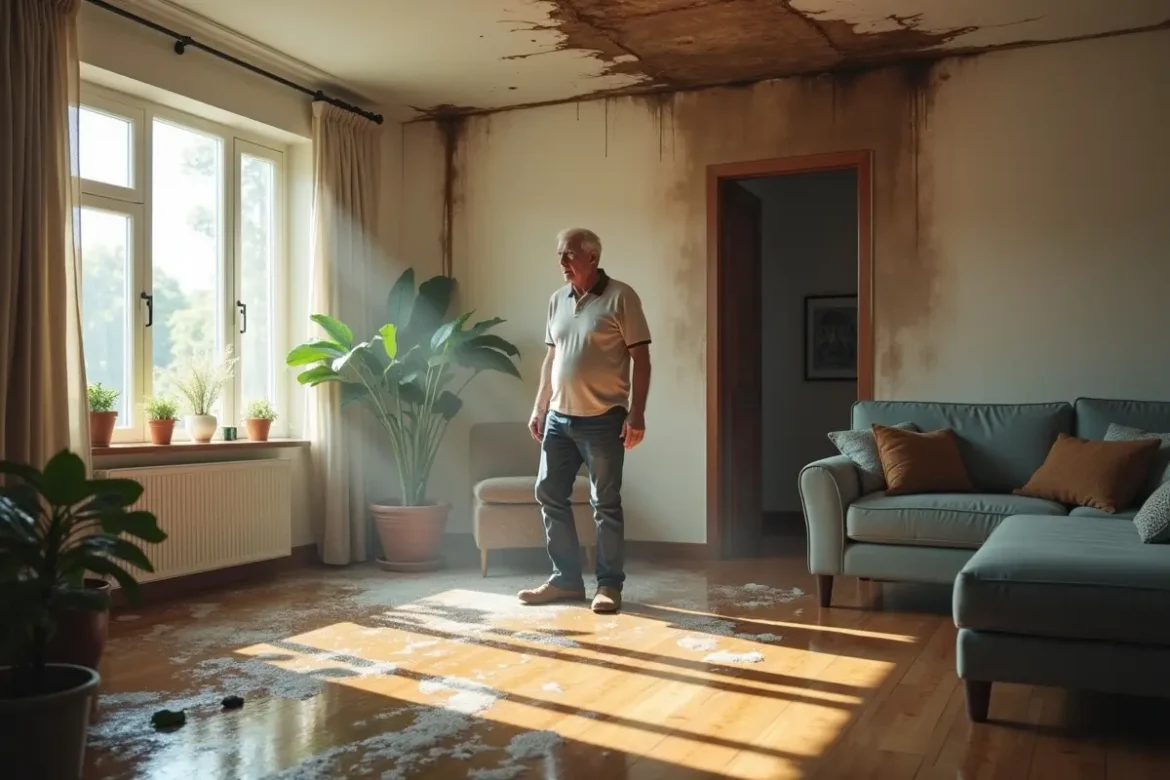
Water moves faster than most people realize. A single broken pipe releases 8–10 gallons per minute. Within minutes, it disappears under floors and behind walls. Understanding how fast water damage spreads determines whether you face a simple cleanup or a six-figure rebuild. This detailed timeline reveals exactly what happens hour by hour — and why speed is your home’s best defense.
Contents
- 1 The Critical First Hour: Invisible Invasion Begins
- 2 Within 24 Hours: Contamination Levels Skyrocket
- 3 48 Hours: Damage Becomes Largely Irreversible
- 4 Porous vs. Non-Porous Materials: Speed of Absorption
- 5 72 Hours and Beyond: Total System Compromise
- 6 Why Delaying Restoration Multiplies Costs Dramatically
- 7 Professional Response vs. DIY: The Speed Gap
- 8 Prevention Technologies That Buy Precious Hours
- 9 Conclusion: Time Is Your Home’s Greatest Enemy
The Critical First Hour: Invisible Invasion Begins
Water never stays where it lands. Gravity pulls it downward. Capillary action draws it upward and sideways. One gallon covers roughly 18 square feet of subfloor in under 20 minutes. Drywall wicks moisture 18 inches high in the same period. Electronics exposed to water fail almost instantly.
How Fast Water Damage Spreads in the First 60 Minutes
Carpet padding becomes fully saturated. Wood flooring cups at the edges. Baseboards swell visibly. Water enters wall cavities through electrical boxes. Insulation absorbs moisture like a sponge. Odors remain absent. Damage stays largely hidden from view.
Moisture meters already read above 40% in affected materials. Relative humidity in the room climbs rapidly. The foundation for secondary damage is now complete.
Within 24 Hours: Contamination Levels Skyrocket
Moisture levels exceed safe thresholds. Paper-faced drywall begins to sag. Laminate flooring delaminates. Metal surfaces show first signs of corrosion. Category 1 water turns Category 2 (gray water) through organic contamination.
Microbial Growth Acceleration After Water Exposure
Fungi germinate in 18–24 hours when temperatures range 68–86°F. Bacteria double every 20 minutes in ideal conditions. Mold spores travel through HVAC systems. Musty odors become noticeable. Air quality drops dramatically.
Stachybotrys (black mold) can begin colonizing within 24 hours on wet gypsum board. Aspergillus and Penicillium follow quickly. These organisms release mycotoxins that affect respiratory health.
48 Hours: Damage Becomes Largely Irreversible
Black mold covers large areas. Structural lumber loses 30–50% of its strength. Vinyl flooring buckles permanently. Category 2 water becomes Category 3 (black water). Biohazard protocols become mandatory.
How Fast Water Damage Spreads to Load-Bearing Elements
Engineered floor joists delaminate completely. Rim joists soften dangerously. Particleboard furniture disintegrates. Sill plates rot at foundation connections. Structural engineers often require reinforcement or replacement.
Hardwood floors crown and cup beyond repair. Ceramic tile grout lines turn black. Metal door frames rust through. The home’s structural integrity now hangs in the balance.
Porous vs. Non-Porous Materials: Speed of Absorption
Porous materials absorb water instantly. Non-porous surfaces resist but redirect flow. Hidden porous materials cause the most expensive damage.
Materials That Accelerate Water Damage Spread
- Gypsum drywall and joint compound
- Fiberglass and cellulose insulation
- OSB and plywood subfloor
- Carpet padding and underlayment
- Hardwood and engineered wood flooring
Non-porous materials like ceramic tile, glass, and solid metal slow surface spread but channel water into seams and joints. Sealed concrete resists longest but cracks allow deep penetration.
72 Hours and Beyond: Total System Compromise
Mold penetrates deep into substrates. Wood rot fungi destroy cellulose. Electrical wiring insulation fails. HVAC systems require full duct replacement. Health risks force temporary relocation.
Long-Term Consequences of Delayed Response
Structural repairs exceed $50,000 in many cases. Mold remediation costs climb past $25,000. Electrical rewiring becomes mandatory. Insurance claims face “lack of urgency” denials.
Why Delaying Restoration Multiplies Costs Dramatically
Every 24-hour delay increases total restoration cost by 40–80%. Drying shifts to demolition. Containment requirements escalate exponentially. Health department involvement becomes likely.
Cost Escalation Timeline for Water Damage
| Time Frame | Average Cost | Primary Work |
| 0–48 hours | $3,000–$9,000 | Extraction + drying |
| 48–96 hours | $12,000–$35,000 | Selective demolition + antimicrobial |
| 5+ days | $40,000–$120,000+ | Full gut + rebuild |
These figures come from IICRC-certified restoration data across thousands of claims.
Professional Response vs. DIY: The Speed Gap
Consumer equipment lacks commercial power. Home dehumidifiers remove 30–70 pints per day. Professional LGR units extract 130–200 pints. Truck-mounted extractors remove 1,000+ gallons per hour.
Why Professional Teams Win the Time Battle
Certified technicians arrive within 60–90 minutes. They deploy desiccant dehumidifiers and injectidry systems. Moisture mapping ensures no area stays wet. For 24/7 emergency response in the Bay Area, companies you can contact here set the standard for speed and effectiveness.
Prevention Technologies That Buy Precious Hours
Smart systems detect leaks instantly. Automatic water shut-off valves activate in seconds. Wi-Fi sensors alert phones worldwide.
Tools That Stop Damage Before It Spreads
- Whole-home leak detection with auto shut-off
- Battery-backed water alarms under every fixture
- Smart water heaters with leak sensors
- Pressure-monitoring plumbing systems
Conclusion: Time Is Your Home’s Greatest Enemy
Understanding how fast water damage spreads transforms panic into power. The first 48 hours decide everything. Professional intervention within the golden window preserves materials, protects health, and saves fortunes. Your home deserves immediate action the moment water escapes. One call can save tens of thousands and months of stress.



